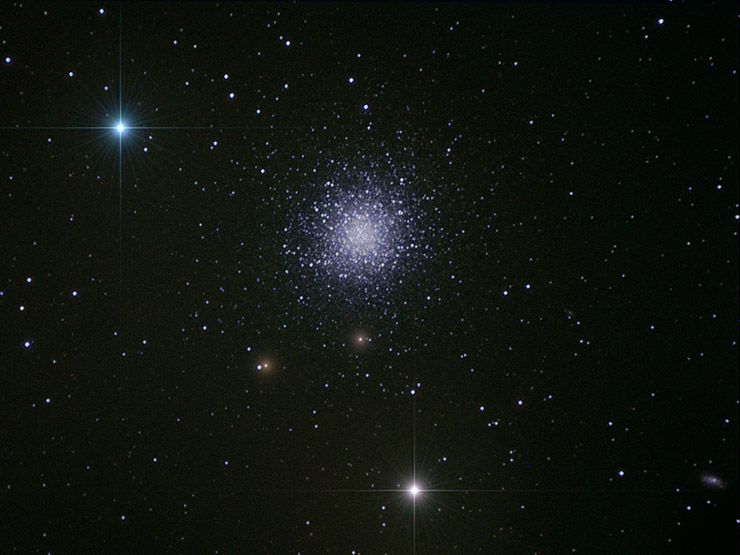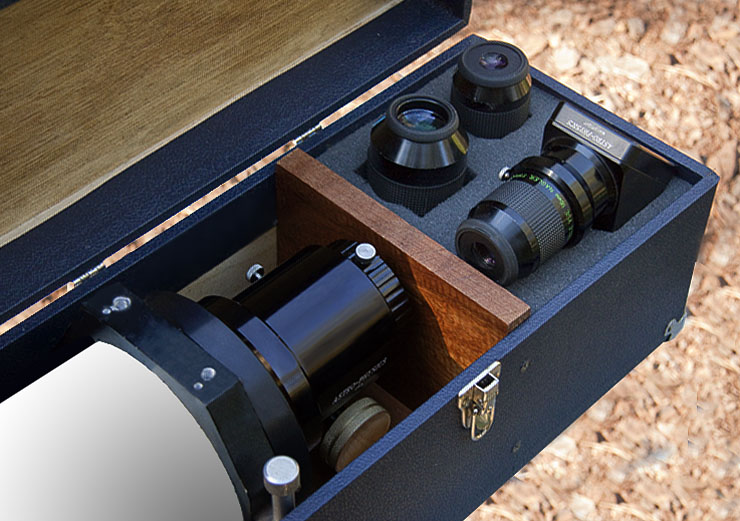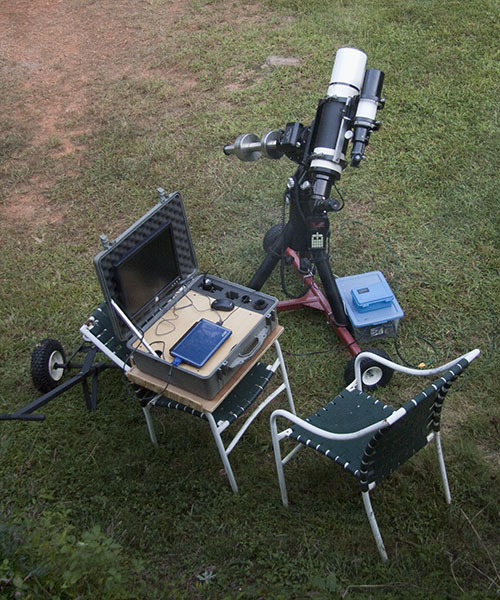|
9/29/2010: Working up last night's
M13 data. Globular
clusters hypnotize me. The view of M3 in the 26-inch Clark refractor
at UVa in Charlottesville, Virginia; M22 in a 17.5-inch dobsonian
at the Texas Star Party; M3 (again) in the 25-inch Obsession at Chaco
Canyon: I'm forever trying to reproduce and share those visual
experiences. Fortunately, a sharp refractor, a CCD camera, and a good
mount seem adequate. What is missing is technique.
Working on it.
Tonight, I aligned on the pole with reasonable care,
focused using the triangular mask recommended by both SBIG and Ron Wodaski,
and then ran a series of 100 second exposures: 10 captures each
in luminance, red, green, and blue. The R, G, and B images seem
significantly sharper, so the photo below does not use the luminance
data:

Click the image for a bigger view and to see more
technical details.
As it happens, clouds moved in over the
course of this session, so the red filter (the last used) saw significantly
less light than the green, which saw less than the blue. That made getting
a good color balance challenging, maybe impossible. I tried assigning
custom weights to the channels in Maxim DL5 and continued tweaking the
image in Photoshop until the background was some semblance of neutral
and the stars of M13 approximately white. Brilliant
supergiants add subtle color to these clusters, and their
contribution is almost entirely lost in this data. Pushing the starved
red channel any harder makes a mess of other aspects
of the photo. The little galaxy in the lower right, familiar
to observers of M13, deserves some attention during image preparation.
Much of its subtle outer structure is visible in the raw data and should
be better preserved in the final image.
For next
time: use
the fine focus tool in Nebulosity (focus was just
a little soft in this image). Note that a Bahtinov mask from Farpoint
via Agena is only $20 shipped. I don't see much reason to use longer
subframes with M13. 100-second subs work well to prevent the core from
burning out, and they do not require guiding with the A-P mount. Sooner
or later, I'm going to have to work out a couple of guiding schemes (again)
and make them routine. That won't happen until late October or November
because I have a lot of earthbound stuff to deal with for the next few
weeks.
10/30/2010: I replaced the desiccant
plug in the ST2000XM with a Particle Wave Technologies kit.
I should probably have waited a few months in order to exploit and
enjoy the newly recharged
OEM desiccant, but curiousity about how the kit worked (and the fear
that I might lose it before it was actually needed) inspired me to go
ahead and install it immediately. The extra pieces, instructions, and
tool are all stored behind the egg-carton foam on the top of the ST2000's
Pelican case.
Speaking of foam, I removed
the foam from
the dark blue original case for the A-P refractor. It had the consistency
of sponge cake. It felt moist and fell apart under little more than
a glance. This case was made in 1986, so I suppose I should not be
surprised that the foam had totally broken down. Absent the foam, the
5-inch just fits with its rings attached. A little clean-up, a couple
of braces on the bottom, some polyurethane, and I'll have a traveling case
for the A-P. So, it looks as if I have been
blindsided by a project that needs doing before I leave for TN on Monday.
Not quite a week later, we leave for the Bluiffs Lodge in Doughton
State Park, where I have long wanted to do some stargazing.
I've sanded and polyurethaned the
interior tonight. Tomorrow I'll cut some wood and either dry fit it or
glue and screw it together.
Addendum 10/10/01: Looky!
That worked out well. Sea trials in Tennessee and Doughton Park over
the next couple of weeks:

A bit of oiled cherry leftover from the
dulcimer project and some scrap foam from this and that made all the
difference. The bare
case neatly holds the A-P in its rings, with dew shield. The telecompressor
is retracted into the focuser body; the 35mm Panoptic, 12mm and 16mm
Naglers, a Maxbright diagonal, and a 2-inch extension are all packed
into the endzone. If I opted to use the flexible dewshield, I could
put a similar foam insert at the other end of the case. I have ideas
about how to do that in "convertible" form so I can waffle
all I want when packing the telescope. There's no room for the bracketry
for the guiding kit which will have to travel with the guidescope
(duh) when needed.
Straightening up the office, I
moved a box
of astronomical sundries to the workshop downstairs: focusers, finders,
rings, and the 4-inch F6 achromat I bought with the idea of supercharging
the solar telescope. I think I will use it as a guidescope instead.
It should offer a log((100/80) ^ 2)/ (log (100^0.2)) = 0.48 mag advantage
over the Orion ST80. Worthwhile? Maybe. That's roughly twice as many
potential guidestars. It's stored with a bunch of PVC fittings; needs
something for a dew shield, and could use a bushing to mate the OEM ST80's
focuser to the PVC. Flocking paper that used to be stored in the A-P
case is airing out in the workshop, too. Get the tube length right, make
the bushing, then flock
the tube. No hurry, unlike the case.
Be on the lookout for a
table wtih adjustable legs so I can have a level "office" for
Tom Swift's Telescopic Suitcase. Some telescoping tubing and a few cotter
pins would be a good start. This just won't do in the long run:

|